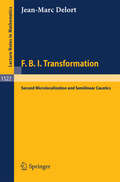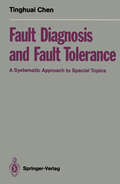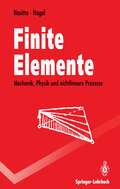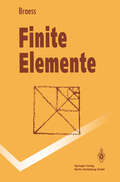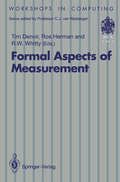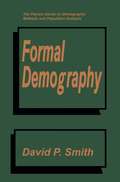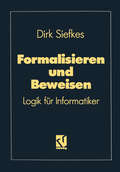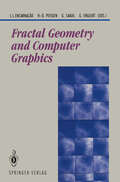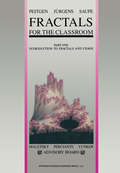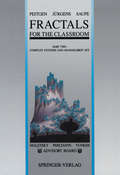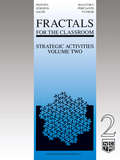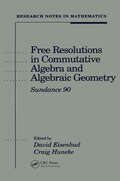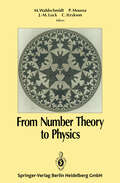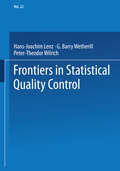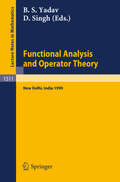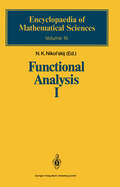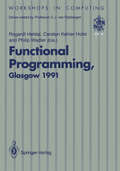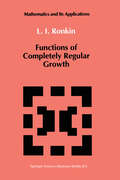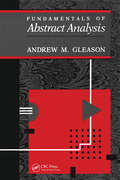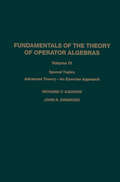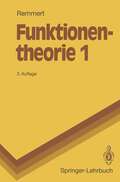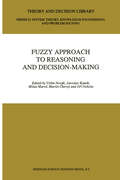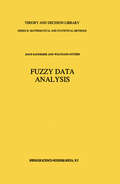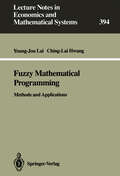- Table View
- List View
F.B.I. Transformation: Second Microlocalization and Semilinear Caustics (Lecture Notes in Mathematics #1522)
by Jean-Marc DelortFault Diagnosis and Fault Tolerance: A Systematic Approach to Special Topics
by Tinghuai ChenWith the rapid growth of integration scale of VLSI chips and the present need for reliable computers in space exploration, fault diagnosis and fault toleran ce have become more important than before, and hence reveal a lot of interest ing topics which attract many researchers to make a great number of contribu tions to this field. In recent years, many new and significant results have been achieved. A quick scan over the proceedings of the conferences on fault tolerant computing and design automation as well as on testing will convince the reader of that. But unfortunately these achievements have not been entire ly reflected in the textbooks, so that there seems to be a gap for the new researcher who already has the basic knowledge and wants to begin research in this area. As a remedy for this deficiency, this book is intended for begin ners, especially graduate students, as a textbook which will lead them to the frontier of some branches of the fault-tolerant computing field. The first chapter introduces the four-valued logic B4 and its applica tions. In 1966 Roth first proposed this four-valued logic as a technique to generate tests for logical circuits, but this work did not concern the mathe matical basis of B4 itself.
Finite Elemente: Mechanik, Physik und nichtlineare Prozesse (Springer-Lehrbuch)
by Karlheinz Nasitta Harald HagelFinite Elemente: Theorie, schnelle Löser und Anwendungen in der Elastizitätstheorie (Springer-Lehrbuch)
by Dietrich BraessFormal Aspects of Measurement: Proceedings of the BCS-FACS Workshop on Formal Aspects of Measurement, South Bank University, London, 5 May 1991 (Workshops in Computing)
by Tim Denvir Rosalind Herman Robin WhittyThis book contains the eight invited papers presented at the workshop on Formal Aspects of Measurement held at South Bank University on 5th May 1991, organised by the British Computer Society's Special Interest Group on Formal Aspects of Computer Science (FACS). In addition, there are five papers which have been included because of their relevance to the subject of the workshop. The book represents something of a landmark in software engineering research. The British Computer Society's Special Interest Group on Formal Aspects of Computer Science (FACS) has an established reputa tion among researchers in formal methods of software specification, design and validation. These researchers have not in the past paid much attention to software measurement. Perhaps software measurement re search was felt to have emphasised its management potential at the expense of proper scientific foundations? At any rate, for the FACS group to host a workshop in this field is recognition of the significant body of formal measurement theories and techniques which has now become available to software engineers.
Formal Demography (The Springer Series on Demographic Methods and Population Analysis)
by David P. SmithThis book is intended as a relatively nontechnica1 introduction to eurrent demographie methods. It has been several years in preparation, beginning from occasional class handouts I wrote to elaborate on essential points of demographie methodology. Its growth from scattered notes to an integrated text was a natural process, if a gradual one. The eontent of the book addresses three objectives. first, I have tried to avoid demographie methods that are now dated. In some ehapters, that has meant eoncentrating on formulas most demographers recognize. In the ehap ters on life tables, it meant testing competing formulas on a variety of real and synthetie data se.ts, and dropping or relegating to footnotes those that were least accurate. Second, I have attempted to give readers a sense of the limits of different formulas and methods. I am a terse writer, however, and for the reader that means most sentences carry weight. Chapters should be read attentively, with careful regard to commentary as weIl as to formulas and examples. Finally, I have tried to make the principal methodologies of the book accessible, by offering explanations for formulas that are not obvious, by keeping examples to the forefront, and by placing relatively specialized topics in ehapter appendices.
Formalisieren und Beweisen: Logik für Informatiker (Lehrbuch Informatik)
by Dirk SiefkesGregory Bateson -Biologe, Anthropologe, Psychiater, Systemtheoretiker -erzählt in der Ein l leitung zu seinem Buch Geist und Natur eine Geschichte: Ein Mann gibt in seinen Computer die Frage ein: "Wirst Du jemals denken wie ein Mensch? Rechne mal nach!" Der Computer rechnet und rechnet und gibt schließlich aus: Dabei fallt mir eine Geschichte ein. Die Geschichte dieses Buches handelt von Menschen. "Fangt doch jeden Abschnitt mit einem Beispiel an", schlug Ralf-Detlef Kutsche vor, als er mir 1982 zusammen mit Peter Padawitz, Simone Pribbenow und Andreas Schulze half, die Lehrveranstaltung Logik für Informatiker durchzuführen. "Fragen und Aufgaben regen besser zum Arbeiten an als Begriffe und Sätze. " Deswegen beginnt jeder Teil dieses Buches mit einer Geschichte, die als Arbeitsmaterial dient: Die Einführung mit dem Problem des Affen mit der Banane, die Aussagenlogik mit der Ballwurf logelei, die Offene Prädikatenlogik mit dem Architektenbeispiel und die volle Prädikatenlogik mit der Geometrie Euklids. Deswegen endet jeder Abschnitt mit Aufgaben und Fragen, die wesentlich fürs Verstehen sind. Deswegen sieht man beim Blättern so wenig Beweise: Ich ent wickle einen Beweis lieber aus einer Fragestellung und formuliere das Ergebnis als Satz, statt mit dem Satz zu beginnen. Deswegen sind die Themen des Buches Formalisieren und Verstehen, Tätigkeiten, und nicht Logik und Informatik, Gebiete. Ich behandle in dem Buch im wesentlichen die klassischen Grundthemen der mathematischen Logik: logische Folgerung, Ableitung, Vollständigkeit, logische Theorie, Axiomensystem. Es geht mir aber nicht darum, diese Begriffe und ihre Eigenschaften darzustellen.
Fractal Geometry and Computer Graphics (Beiträge zur Graphischen Datenverarbeitung)
by Jose L. Encarnacao Heinz-Otto Peitgen Georgios Sakas Gabriele EnglertFractal geometry has become popular in the last 15 years, its applications can be found in technology, science, or even arts. Fractal methods and formalism are seen today as a general, abstract, but nevertheless practical instrument for the description of nature in a wide sense. But it was Computer Graphics which made possible the increasing popularity of fractals several years ago, and long after their mathematical formulation. The two disciplines are tightly linked. The book contains the scientificcontributions presented in an international workshop in the "Computer Graphics Center" in Darmstadt, Germany. The target of the workshop was to present the wide spectrum of interrelationships and interactions between Fractal Geometry and Computer Graphics. The topics vary from fundamentals and new theoretical results to various applications and systems development. All contributions are original, unpublished papers.The presentations have been discussed in two working groups; the discussion results, together with actual trends and topics of future research, are reported in the last section. The topics of the book are divides into four sections: Fundamentals, Computer Graphics and Optical Simulation, Simulation of Natural Phenomena, Image Processing and Image Analysis.
Fractals for the Classroom: Part One Introduction to Fractals and Chaos
by Heinz-Otto Peitgen Hartmut Jürgens Dietmar SaupeFractals for the Classroom breaks new ground as it brings an exciting branch of mathematics into the classroom. The book is a collection of independent chapters on the major concepts related to the science and mathematics of fractals. Written at the mathematical level of an advanced secondary student, Fractals for the Classroom includes many fascinating insights for the classroom teacher and integrates illustrations from a wide variety of applications with an enjoyable text to help bring the concepts alive and make them understandable to the average reader. This book will have a tremendous impact upon teachers, students, and the mathematics education of the general public. With the forthcoming companion materials, including four books on strategic classroom activities and lessons with interactive computer software, this package will be unparalleled.
Fractals for the Classroom: Part Two: Complex Systems and Mandelbrot Set
by Heinz-Otto Peitgen Hartmut Jürgens Dietmar SaupeFractals for the Classroom breaks new ground as it brings an exciting branch of mathematics into the classroom. The book is a collection of independent chapters on the major concepts related to the science and mathematics of fractals. Written at the mathematical level of an advanced secondary student, Fractals for the Classroom includes many fascinating insights for the classroom teacher and integrates illustrations from a wide variety of applications with an enjoyable text to help bring the concepts alive and make them understandable to the average reader. This book will have a tremendous impact upon teachers, students, and the mathematics education of the general public. With the forthcoming companion materials, including four books on strategic classroom activities and lessons with interactive computer software, this package will be unparalleled.
Fractals for the Classroom: Strategic Activities Volume Two
by Heinz-Otto Peitgen Hartmut Jürgens Dietmar Saupe Evan Maletsky Terry Perciante Lee YunkerThe same factors that motivated the writing of our first volume of strategic activities on fractals continued to encourage the assembly of additional activities for this second volume. Fractals provide a setting wherein students can enjoy hands-on experiences that involve important mathematical content connected to a wide range of physical and social phenomena. The striking graphic images, unexpected geometric properties, and fascinating numerical processes offer unparalleled opportunity for enthusiastic student inquiry. Students sense the vigor present in the growing and highly integrative discipline of fractal geom etry as they are introduced to mathematical developments that have occurred during the last half of the twentieth century. Few branches of mathematics and computer science offer such a contem porary portrayal of the wonderment available in careful analysis, in the amazing dialogue between numeric and geometric processes, and in the energetic interaction between mathematics and other disciplines. Fractals continue to supply an uncommon setting for animated teaching and learn ing activities that focus upon fundamental mathematical concepts, connections, problem-solving techniques, and many other major topics of elementary and advanced mathematics. It remains our hope that, through this second volume of strategic activities, readers will find their enjoyment of mathematics heightened and their appreciation for the dynamics of the world in creased. We want experiences with fractals to enliven curiosity and to stretch the imagination.
Free Resolutions in Commutative Algebra and Algebraic Geometry
by David Eisenbud Craig HunekeThe selected contributions in this volume originated at the Sundance conference, which was devoted to discussions of current work in the area of free resolutions. The papers include new research, not otherwise published, and expositions that develop current problems likely to influence future developments in the field.
Free Resolutions in Commutative Algebra and Algebraic Geometry
The selected contributions in this volume originated at the Sundance conference, which was devoted to discussions of current work in the area of free resolutions. The papers include new research, not otherwise published, and expositions that develop current problems likely to influence future developments in the field.
From Number Theory to Physics
by P. Cartier J. B. Bost H. Cohen D. Zagier R. Gergondey H. M. Stark E. Reyssat F. Beukers G. Christol M. Senechal A. Katz J. Bellissard P. Cvitanovic J. C. YoccozThe present book contains fourteen expository contributions on various topics connected to Number Theory, or Arithmetics, and its relationships to Theoreti cal Physics. The first part is mathematically oriented; it deals mostly with ellip tic curves, modular forms, zeta functions, Galois theory, Riemann surfaces, and p-adic analysis. The second part reports on matters with more direct physical interest, such as periodic and quasiperiodic lattices, or classical and quantum dynamical systems. The contribution of each author represents a short self-contained course on a specific subject. With very few prerequisites, the reader is offered a didactic exposition, which follows the author's original viewpoints, and often incorpo rates the most recent developments. As we shall explain below, there are strong relationships between the different chapters, even though every single contri bution can be read independently of the others. This volume originates in a meeting entitled Number Theory and Physics, which took place at the Centre de Physique, Les Houches (Haute-Savoie, France), on March 7 - 16, 1989. The aim of this interdisciplinary meeting was to gather physicists and mathematicians, and to give to members of both com munities the opportunity of exchanging ideas, and to benefit from each other's specific knowledge, in the area of Number Theory, and of its applications to the physical sciences. Physicists have been given, mostly through the program of lectures, an exposition of some of the basic methods and results of Num ber Theory which are the most actively used in their branch.
Frontiers in Statistical Quality Control (Frontiers in Statistical Quality Control #4)
by Hans-Joachim Lenz G. Barry Wetherill Peter-Theodor WilrichLike the first three volumes, published in 1981, 1984 and 1987 and met with a lively response, the present volume is collecting contributions stressed on methodology or successful industrial applications. The papers are classified under three main headings; sampling inspection, process quality control and experimental design. In the first group there are nine papers on acceptance sampling. The second large group of papers deal with control charts and process control and the third group of papers includes contributions on experimental design.
Functional Analysis and Operator Theory: Proceedings of a Conference held in Memory of U.N.Singh, New Delhi, India, 2-6 August, 1990 (Lecture Notes in Mathematics #1511)
by B. S. Yadav D. SinghFunctional Analysis I: Linear Functional Analysis (Encyclopaedia of Mathematical Sciences #19)
by Yu.I. LyubichThe twentieth-century view of the analysis of functions is dominated by the study of classes of functions. This volume of the Encyclopaedia covers the origins, development and applications of linear functional analysis, explaining along the way how one is led naturally to the modern approach.
Functional Programming, Glasgow 1991: Proceedings of the 1991 Glasgow Workshop on Functional Programming, Portree, Isle of Skye, 12–14 August 1991 (Workshops in Computing)
by Rogardt Heldal Carsten K. Holst Philip WadlerThe Glasgow functional programming group has held a workshop each summer since 1988. The entire group, accompanied by a selection of colleagues from other institutions, retreats to a pleasant Scottish location for a few days. Everyone speaks briefly, enhancing coherence, cross fertilisation, and camaraderie in our work. The proceedings of the first workshop were published as a technical report. Demand for this was large enough to encourage wider publication, and subsequent proceedings have been published in the Springer-Verlag Workshops in Computing series. These are the proceedings of the-meeting held 12-14 August 1991, in Portree on the Isle of Skye. A preliminary proceedings was prepared in advance of the meeting. Most presentations were limited to a brief fifteen minutes, outlining the essentials of their subject, and referring the audience to the pre-print proceedings for details. Papers were then refereed and rewritten, and you hold the final results in your hands. A number of themes emerged at this year's workshop, including relational algebra and its application to hardware design, partial evaluation and program transformation, implementation techniques, and strictness analysis. We were especially pleased to see applications of functional programming emerge as a theme. One of the sessions was devoted to a lively discussion of applications, and was greatly enhanced by our industrial participants. The workshop was organised by Kei Davis, Cordelia Hall, Rogardt Heldal, Carsten Kehler Holst, John Hughes, John O'Donnell, and Satnam Singh all from the University of Glasgow.
Fundamentals of Abstract Analysis
by Andrew GleasonThis classic is an ideal introduction for students into the methodology and thinking of higher mathematics. It covers material not usually taught in the more technically-oriented introductory classes and will give students a well-rounded foundation for future studies.
Fundamentals of the Theory of Operator Algebras: Special Topics Advanced Theory—An Exercise Approach
by KADISON RINGROSEThese volumes are companions to the treatise; "Fundamentals of the Theory of Operator Algebras," which appeared as Volume 100 - I and II in the series, Pure and Applied Mathematics, published by Academic Press in 1983 and 1986, respectively. As stated in the preface to those volumes, "Their primary goal is to teach the sub ject and lead the reader to the point where the vast recent research literature, both in the subject proper and in its many applications, becomes accessible." No attempt was made to be encyclopcedic; the choice of material was made from among the fundamentals of what may be called the "classical" theory of operator algebras. By way of supplementing the topics selected for presentation in "Fundamentals," a substantial list of exercises comprises the last section of each chapter. An equally important purpose of those exer cises is to develop "hand-on" skills in use ofthe techniques appearing in the text. As a consequence, each exercise was carefully designed to depend only on the material that precedes it, and separated into segments each of which is realistically capable of solution by an at tentive, diligent, well-motivated reader.
Funktionentheorie 1 (Springer-Lehrbuch)
by Reinhold RemmertAus den Besprechungen: "Aufgelockert durch viele Beispiele und Übungsaufgaben, wird die Theorie der Funktionen einer komplexen Veränderlichen bis zum Residuenkalkül entwickelt. Im Zentrum stehen die Integralsätze von Cauchy. Dabei begnügt sich der Autor oft nicht mit einem einzigen Beweis für einen Satz. Weitere Beweismöglichkeiten werden zumindest skizziert, oder man erhält genaue Angaben über die Originalarbeiten. Ebenso wird auf die ursprüngliche Formulierung von Sätzen hingewiesen. Jeder Paragraph schließt mit historischen Hinweisen, die auch die persönlichen Beziehungen der Beteiligten nicht ausklammern. So erfährt man natürlich die unterschiedlichen Standpunkte von Cauchy und Weierstrass. Neben den Themen, die in keinem Text zur Funktionentheorie fehlen dürfen, findet man auch "Raritäten", etwa: Eisensteins Zugang zu den trigonometrischen Funktionen mittels Reihen oder Ritts Satz über asymptotische Reihenentwicklung, welcher einen berühmten Satz von E. Borel enthält. Das Buch kann als Lehrbuch für Anfänger dienen, aber es ist mehr: Ein Werk, das allen Mathematikern die Funktionentheorie näherbringen kann." #Elemente der Mathematik#1
Fuzzy Approach to Reasoning and Decision-Making: Selected Papers of the International Symposium held at Bechyně, Czechoslovakia, 25-29 June 1990 (Theory and Decision Library D: #8)
by Vilém Novák Jirí Nekola Jaroslav Ramík Milan Mares Martin CernýSelected Papers of the International Symposium held at Bechyne, June 25-29, 1990
Fuzzy Data Analysis (Theory and Decision Library B #20)
by Hans Bandemer Wolfgang NätherFuzzy data such as marks, scores, verbal evaluations, imprecise observations, experts' opinions and grey tone pictures, are quite common. In Fuzzy Data Analysis the authors collect their recent results providing the reader with ideas, approaches and methods for processing such data when looking for sub-structures in knowledge bases for an evaluation of functional relationship, e.g. in order to specify diagnostic or control systems. The modelling presented uses ideas from fuzzy set theory and the suggested methods solve problems usually tackled by data analysis if the data are real numbers. Fuzzy Data Analysis is self-contained and is addressed to mathematicians oriented towards applications and to practitioners in any field of application who have some background in mathematics and statistics.
Fuzzy Mathematical Programming: Methods and Applications (Lecture Notes in Economics and Mathematical Systems #394)
by Young-Jou Lai Ching-Lai HwangIn the last 25 years, the fuzzy set theory has been applied in many disciplines such as operations research, management science, control theory,artificial intelligence/expert system, etc. In this volume, methods and applications of fuzzy mathematical programming and possibilistic mathematical programming are first systematically and thoroughly reviewed and classified. This state-of-the-art survey provides readers with a capsule look into the existing methods, and their characteristics and applicability to analysis of fuzzy and possibilistic programming problems. To realize practical fuzzy modelling, we present solutions for real-world problems including production/manufacturing, transportation, assignment, game, environmental management, resource allocation, project investment, banking/finance, and agricultural economics. To improve flexibility and robustness of fuzzy mathematical programming techniques, we also present our expert decision-making support system IFLP which considers and solves all possibilities of a specific domain of (fuzzy) linear programming problems. Basic fuzzy set theories, membership functions, fuzzy decisions, operators and fuzzy arithmetic are introduced with simple numerical examples in aneasy-to-read and easy-to-follow manner. An updated bibliographical listing of 60 books, monographs or conference proceedings, and about 300 selected papers, reports or theses is presented in the end of this study.
